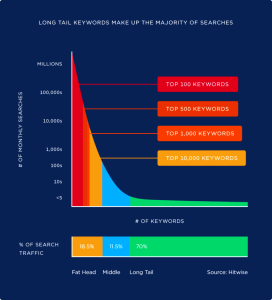Keyword research is a foundational function in SEO, connecting people to the content they need. Most of the time, users must be more specific regarding what they are looking for and rely on a search engine to interpret their search and direct them toward helpful information. How do your customers find you if your company doesn’t appear on that results list?
More importantly, however, effective keyword research takes work. From nuanced user intent to emerging search trends, this is what makes business competition extremely difficult. Today, in 2024, mastering the process involves more than just pinpointing popular terms that require innovative AI-driven tools and a strategic approach for businesses to stay ahead of the game.
This guide tackles these challenges head-on and shows you how to attract organic traffic, drive conversions, and get accurate results. Let’s start by understanding how to connect with the beginning of the search experience and build a thriving SEO strategy in today’s complex digital world.
Contextualizing User Intent in Keyword Research
When buyers start looking for a new product, service, or information, they often resort to the internet. They rely heavily on well-known search engines like Google, Yahoo!, and Bing. While prospects may have a broad concept of what they are searching for, they trust search engines to help them navigate and narrow down their alternatives. In fact, Organic search drives 53.3% of all web traffic, making it a crucial driver for web visibility. (Sources: BrightEdge Research)
To acquire organic traffic, knowing user intent through keyword research is critical. By determining what consumers are looking for, schools may produce material that not only engages potential families but also increases their exposure on SERP (search engine results pages).

But, what is keyword research?
Keyword research is a way of identifying and evaluating search phrases that people type into search engines with the intention of using the data for a specific purpose, most commonly for SEO (search engine optimization) or general marketing. It can identify queries to target, their popularity, ranking difficulties, and more.
However, keyword research is more than just uncovering hot search words; it is also about connecting with the motives behind each inquiry.
The Role of User Intent in Keyword Research
When consumers search, they have certain goals in mind, such as learning, comparing, navigating, or purchasing. Recognizing these aims, known as “user intent,” enables firms to better customize their content to the demands of their target audience.

The four main categories of user intent are:
- Informational Intent: Users seek information or advice, like “how to do keyword research.” The content for this intent should be instructive and thorough.
- Navigation Intent: Users desire to discover a certain website or resource, such as “Twitter login” or “Ahrefs blog.” The content should be concise and link directly to the targeted site.
- Commercial Intent: Users investigate items and often compare possibilities (e.g., “best running shoes 2024”). Content, such as comparisons or product reviews, should help influence decision making.
- Transactional Intent: Users are prepared to make a transaction, such as “buy SEO tools.” Content should be convincing and have clear calls to action.
Strategic keyword research allows firms to tap into large amounts of lucrative, organic traffic. It walks customers through the buying process, encouraging meaningful participation, increasing on-page engagement, and enhancing click-through rates.
SEO Evolution: From Keywords to User Intent
Search engines, particularly Google, have progressed in their ability to comprehend and prioritize material. Google’s semantic search innovations now prioritize comprehending the larger meaning of inquiries, rewarding material that corresponds with intent instead of individual terms. This change stimulates the production of content clusters, which are related articles that delve deeply into a topic. This method allows organizations to target major keywords and associated phrases, appealing to a variety of search intents inside a single content ecosystem.
Importance of E-E-A-T and User-Centric SEO in Keyword Research
Google’s E-E-A-T (Expertise, Experience, Authority, Trustworthiness) strategy emphasizes high-quality, user-centric content. Keywords are no longer sufficient; they must be accompanied with genuine information and real-world experience. To match both user needs and Google’s criteria, a blog article on “best SEO tools” should not merely list possibilities but also provide in-depth insights, preferably based on own experience.
The user-centric SEO approach seeks to plug the gap created by the 96.55% of websites that do not generate organic traffic. Websites that provide content that actually fulfills user requirements can become reliable resources that Google favors, increasing search visibility and user confidence. (Source: 2023 Organic Search Study by Ahrefs)

User Intent in 2024: Moving Beyond Popularity
For 2024, effective keyword research will include a thorough grasp of user intent, empowering content creators to go beyond popular terms and target unique audience demands. With AI and machine learning improving analytical tools, businesses can now identify keywords that correspond to intent-driven, trustworthy content. This method not only improves search ranks but also fosters long-term connections with audiences, achieving Google’s priorities of authority, relevancy, and user pleasure.
How to Optimize SEO Content for User Intent?
To properly optimize for user intent, start by examining the top-ranked content for the target keywords. This method reveals what consumers are looking for and which content types Google favors.
For example, visitors looking for “SEO audit” frequently prefer detailed manuals and checklists than automated programs. This trend indicates that these consumers prefer extensive, step-by-step guidance to perform their own audits rather than just a product recommendation.
Google’s algorithm increasingly promotes content that closely matches user intent. As a result, adjusting your content to fit current consumer expectations is critical.
Here’s how to tackle this strategically:
1. Research and Analyze Query Results:
Examine the SERP (search engine results page) for your selected keywords. Take note of the dominant tone, format, and content type among the top results. Are they product comparisons, how-to posts, or quick-answer guides? For example, searches for “SEO audit” reveal that customers frequently seek detailed instructions that give concrete measures that they can take independently.
2. Use a Targeted Structure:
Make sure the content structure is consistent with what consumers find valuable. Include aspects such as short bullet points, informative headings, and clear sections that answer frequently asked issues. Use visual aids (such as photos, diagrams, and films) to simplify complicated content and increase participation. This format not only makes the text easier to understand, but it also accommodates different learning styles and retains readers.
3. Offer Actionable Insights:
Beyond just describing a topic, provide actionable activities, tools, and checklists when applicable. As an example in an SEO audit manual, include sections on how to use tools such as Google Analytics, how to evaluate site performance, and how to improve mobile responsiveness. This effective approach corresponds with consumer needs for “SEO audit” material, increasing the user’s opinion of your guide.
4. Content Freshness:
Revise and update current material on a regular basis to reflect changing user intent. This might include adding new sections, updating obsolete material, or refining multimedia features to keep the content current and valuable. User intent might change over time, and proactive updates guarantee that your content stays relevant, resulting in sustained engagement and rankings.
Case Study:
A recent case study by Brian Dean demonstrates the importance of matching content with user intent, which resulted in a 652% increase in organic traffic within a week. In the beginning, SEO content post gained popularity, but it rapidly lost traction since it did not entirely meet user expectations. After studying the top-ranking web pages, the author determined that consumers were looking for a simple “SEO checklist,” rather than a detailed blog article.
This finding prompted a thorough content makeover utilizing the “Skyscraper Technique 2.0,” that stresses on arranging content to fit consumers’ preferred format and depth. By converting the blog post into a succinct, practical checklist of critical SEO activities, the content recovered top ranks and increased exposure and engagement. This instance demonstrates how keyword research that is user intent-based and content reorganization may directly impact SEO performance.
Using Diverse Keyword Types for Maximum SEO Impact
Understanding various keyword kinds is critical for developing an efficient SEO strategy, since each serves a distinct role in reaching and engaging consumers. Here’s a summary of significant keyword types and how they relate to user intent.
1. Short-Tail vs. Long-Tail Keywords
Short-tail keywords are wide phrases with a large search traffic, such as “SEO tools.” While they can generate a lot of traffic, they also lack specificity and are extremely competitive, making it difficult to rank and attract intent-driven visitors.
Long-tail keywords are very precise phrases that often contain at least 3 words, like “best SEO tools for SMEs.” While these terms have smaller search volumes and are less competitive, they attract people with clear, specific purpose, which frequently results in greater conversion rates.
Notably, a survey finds that 92% of the keywords generate 10 or less monthly queries, demonstrating long-tail keywords‘ dominance in search engine traffic. Their value is heightened by the growth of voice search, in which users naturally utilize descriptive, conversational language to discover what they need.

Source: Backlinko
2. Semantic and Related Keywords
Semantic keywords and related phrases give context for primary keywords, indicating greater in-depth coverage of a topic. For example, a page on “healthy meal prep” may include phrases like “meal planning” and “nutritious recipes.” By include these phrases, content becomes more pertinent and can catch a greater variety of related queries, so increasing both relevance and exposure.
3. LSI (Latent Semantic Indexing) Keywords
LSI (latent semantic indexing) keywords are phrases that appear often with main keywords, providing semantic meaning and depth to information. These keywords aid search engines in comprehending material context, preventing keyword stuffing while improving overall quality and relevancy. For example, LSI keywords for “social media marketing” may contain “audience targeting” and “engagement strategies.”
4. Questions and Conversational Keywords
Question-based keywords such as “how to start a blog” are critical for optimizing content for conversational AI queries and voice search. These keywords enable material to appear in search features such as “People Also Ask” boxes, hence increasing visibility. AI solutions such as ChatGPT may assist develop question-based keywords, allowing for a more conversational content style that aligns with contemporary search patterns.
Step-by-Step Keyword Research Process for 2024
Keyword research today is more data-driven, user-centric, and business-aligned within the highly competitive SEO world. A strategy that considers the three key attributes below is essential.

Master keyword research to transform into 2024 step by step with an advanced guide on driving organic traffic and capitalizing on emerging search trends.
Step 1: Determine Goals and Identify Target Group
Set Clear Business Objectives
Define your business and content goals before keywords. Do you want brand awareness, leads, or e-commerce sales? This will determine your keyword strategy, as you now decide what words best fit what you are trying to accomplish, whether launching a new product, becoming an authority for a brand, or attracting local foot traffic.
Create User Personas
Building a user persona will be the most foundational act of targeting relevant keywords. Determine demographics, pain points, and search behavior—are they looking for “how-to” guides, product comparisons, or detailed tutorials? Knowing that helps you find keywords closely aligned with your audience’s needs and intention to buy.
Step 2: Identify Seed Keywords
Seed ideas Brainstorm
Start with broad keywords related to your products, services, or industry. To create a robust list, analyze how customers describe your offerings and look at user feedback, customer reviews, and competitor keywords. This will also help identify language and terms naturally associated with your business.
Expand with Competitor Analysis
Use tools like Ahrefs or SEMrush to expand your seed list by examining the keywords competitors rank for that align with your objectives but still need to be tapped into your content. A keyword gap analysis will reveal keywords and topics to incorporate into your strategy.
Step 3: Keyword metrics analysis
Evaluate Search Volume, Difficulty, and Competition
One has to balance search volume with competition. High-volume keywords are sure to send massive traffic. Still, when the competition is too heavy, ranking becomes easier. Look for those keywords that have reasonable volumes of search and lower levels of competition. They will generally be a “sweet spot” to attract traffic.
Analyze Keyword Intent
As mentioned above, search intent is the key to success for SEO. We must stress again that keywords come in four primary flavors:
- Informational: Users want to learn something new.
- Navigational: Users search for a particular website.
- Transactional: Users are ready to make a purchase.
- Commercial: Consumers researched the product before purchasing.
So, prioritize keywords that match business goals and the intent behind the user’s search query. For instance, more transactional keywords apply to an e-commerce company. In contrast, a blog’s keywords are more likely informational terms.
Step 4: Execute Advanced Keyword Research Strategies
Map Keywords to User Journey
To capture leads throughout their journey, map keywords to different buyer stages—awareness, consideration, and decision.
Awareness-stage keywords target broad, informational queries (e.g., “What is SEO?”). In contrast, consideration-stage keywords focus on comparison (e.g., “Best SEO tools 2024”). Decision-stage keywords align with purchase intent (e.g., “buy SEO software”).
Group keywords based on intent and link content types:
- Awareness stage with blog posts,
- Consideration stage with product comparisons,
- and decision stage with service pages for decision keywords.
This strategic approach addresses users at every stage, improving engagement and conversion rates.
Competitor Keyword Analysis
Identifying and analyzing competitor keywords can fill content gaps. You can see how high-value keywords your competitors rank for, but you don’t use a keyword gap analysis tool like SEMrush. Filling in these gaps can help drive traffic where competitors have established authority, building your competitive edge.
Use Topic Clustering and Pillar Pages
Topic clusters and pillar pages improve both SEO and user experience.
Set up a pillar page on a broad topic, such as “SEO strategy,” and link out to more specific subtopics like “keyword research” or “competitor analysis.” This helps topical authority, assists with internal linking, and clarifies to search engines that your site is broadly covering the topic.
Utilizing Semantic SEO and NLP Google’s NLP technologies, such as BERT, means more than just focusing on primary keywords is needed. Use related terms, entities, and contextual phrases to align with modern algorithms and improve content discoverability.
For example, for an article on “SEO trends for 2024,” include keywords like “voice search optimization” or “AI in SEO” to show thorough topic coverage.
Step 5: Voice Search and Visual Search Optimization
This optimizes the voice search because it uses more natural and conversational language, mainly in a question format (for example, “How to increase SEO ranking?”). Structured data and featured snippets increase the chances of a voice assistant selecting your response.
Visual search optimization is essential for image—and video-rich niches. Make sure all your visuals have alt tags that describe them, captions, and filenames. Creating image-focused content like infographics supports visual indexing, enhancing your image and visibility in video search results.
Step 6: Use Google Trends and Related Searches for Real-Time Insight
Google Trends would give you trending data on keyword seasonality and location-based trends. Watching for such trends lets you quickly modify your content and keyword approach to match emerging search patterns. For instance, targeting the appropriate keywords during holiday seasons can increase traffic and enhance ranking potential.
Step 7: Add Question-Based Keywords and FAQ sections
Question-based keywords, voice, and conversational search make question-based entities very important. Tools like AnswerThePublic or Google’s “People Also Ask” can be used to identify frequently asked questions relative to your topic. An FAQ section may enhance your chances of ranking for featured snippets as it directly answers the user’s intent and improves SEO performance.
Since approximately 12.3% of search queries display featured snippets, targeting question-based keywords can help optimize those valuable placements, increase visibility, and position your content as the authoritative answer for frequently asked questions. (Source: Ahrefs Study)
How to Craft Effective Keyword-Focused Content Strategy?
On average, 71.33 % of searches result in page 1 organic clicks (some sources say as high as 92%). Pages 2 and 3 get only 5.59% of the clicks. The first five results on the first-page account for 67.60 percent of all the clicks, while the results from 6 to 10 account for just 3.73%. (Source: Organic CTR Study by Advanced Web Ranking)
Keyword-focused content is the key to top rankings since high ranks matter for any campaign’s visibility and engagement. Keyword research content strategy can be a great way to develop raw data into a structured plan with purpose and bring in meaningful results.
Here is how to create a keyword research strategy that ties into user intent, boosts engagement, and maximizes SEO impact.
Organizing Keywords into a Content Calendar
First, rank by most relevant and intent in question: informational, navigational, or transactional intent. Also, critical seasonal factors should be considered to assess every keyword’s search volume and importance to the target audience. Hence, an outdoor gear brand will focus on “best hiking boots” during spring.
A content calendar will guide the posts created because of these factors. Consider structuring it according to month, keyword, and target audience stage. However, your strategy should always come with a sense of adaptability. Downloading from a template will only reduce the time taken, but on track, the efforts done will be more efficient.
Optimizing On-Page Elements Based on Keywords
Once your calendar is set, it’s time to optimize each piece of content. Incorporate primary and secondary keywords naturally into:
- Titles: Engaging and keyword-centric without losing readability.
- Meta Descriptions: Write a content summary using primary keywords for better click-through rates.
- Headers (H1, H2, H3): Headers are a technique for organization and include secondary keywords.
- Body Text: Embed keywords without overstuffing. The goal is to provide readability and satisfaction to users.
This balanced approach enhances SEO and keeps readers engaged.
Monitoring and Adjusting Keyword Performance
Monitor keyword performance regularly to determine what works and where to fine-tune.
Tools such as Google Search Console and Google Analytics help measure CTR, bounce rate, and dwell time—indicators of how well keywords drive engagement and conversion. Modify your calendar to reflect these trends and determine which content needs refreshing.
Effective keyword monitoring and refinement ensure that your strategy remains up-to-date with ever-changing search behavior, unlocking long-term SEO gains.
Emerging Trends Influencing Keyword Research in 2024
As search engine optimization evolves, emerging voice and visual search trends, among many others, keep changing the face of keyword research.
How do these trends impact keyword strategies?
Let’s review these trends and critical ways to adjust approaches to achieve the best outcome in 2024.
1. Voice and Visual Search
Voice and visual searches are also on the uptrend, with increased applications of smart speakers and image-based searching. This means asking more spoken but less typable questions, as most online queries do not typically rely upon traditional keyboard input or a word typed out in word form.
Including keyword methods in a conversational phrasing or question-based type to better reflect the natural act of speaking is necessary for a successful keyword method in 2024.

For example, the keyword “How do I optimize my blog for SEO?” is more effectively captured by voice search than shorter, less targeted terms. AI tools, such as ChatGPT and Google’s “People Also Ask,” can help generate and find conversational keywords, ensuring that content is better aligned with voice search queries.
2. AI and NLP Advancements
Google has pushed AI and Natural Language Processing to new dimensions and altered how people focus on keyword targeting, focusing on context rather than specific keywords. Its recent AI-based update, MUM (Multitask Unified Model), is all set to read across the nuances and connections from different topics while answering any queries.
For instance, instead of stuffing one’s eggs in the keyword basket described as “content marketing,” it is more effective to include relevant words and synonyms, such as “digital content strategy” or “content planning for SEO,” to signal relevance more intensely.
AI-based keyword research tools such as Screpy and Wordtracker allow content creators to determine contextually relevant terms in line with Google’s far more advanced language understanding. This makes it easier to optimize content to meet Google’s contextual relevance expectations and provides the user with highly relevant, value-driven information.
Keyword Research Tools to Use in 2024
Keyword research tools break or make a strategy. Emerging new technologies and ever-changing search behaviors influence these tools and approaches to perfect the best optimization for 2024.
Here is a rundown of the top tools and their use cases:
1. Google Keyword Planner
Although direct from the source, Google Keyword Planner is one strong option for finding related keywords. Since it belongs to the Google Ads set of applications, it provides a count of search volumes and trends calibrated in line with Google’s search.
- Benefits: It is reliable and accessible, seamlessly integrates with Google’s ecosystem, and provides a direct line to user intent and search behavior data.
- Limitations: No specific insights are provided on organic search performance; only general ranges for search volume are provided. It is best used as a starting point but often needs to be supplemented with more advanced tools.
2. Ahrefs & SEMrush
Leverage premium tools like Ahrefs and SEMrush for premium options, keyword research powerhouses, competitor analysis, and complete SEO insights.
Ahrefs will stand out for the quality of its backlink analysis and comes with a very detailed keyword explorer, which displays metrics such as Keyword Difficulty (KD) and Clicks per Search (CPS).
Meanwhile, SEMrush is especially famous for its keyword gap analysis and advertising insights.
Key Uses: These are best suited for finding long-tail keywords, competitor keyword profiles, and backlinking strategies. Advanced metrics make them valuable for in-depth SEO strategies with real-time updates. They best suit agencies or businesses requiring in-depth data and predictive analytics.
3. AI Tools & AI-Driven Platforms
Generate more content ideas with trending keywords and topics created with AI tools like ChatGPT and Google Bard. These tools analyze users’ search trends and language patterns to suggest new, conversational topics aligned with user intent.
How to Apply: Start with seed words and develop a list of pertinent phrases or questions that might be pursued. For example, using the subject “healthy eating,” a list of possible FAQs, topics, and discussions people might want to research could be expanded further into separate articles.
4. Free Tools for Beginners
Affordable alternatives like Ubersuggest and Moz Keyword Explorer are great options for users just starting or those on a budget.
Ubersuggest offers data on search volume and keyword difficulty, with a mix of paid keywords and organic keyword suggestions that are versatile choices for beginners. Moz Keyword also offers insights into keyword opportunities together with SERP analysis insights.
Best Uses: These tools are suitable for researching basic keyword ideas, generating ideas, and finding opportunities in relatively less competitive niches. Though they could be much better in-depth than premium tools, they are still loaded with insights for small businesses or even personal projects.
5. Visual and Voice Search Tools
Voice and visual searches are the two newest search types that redefine SEO. On the forefront are Pinterest Analytics and Alexa Skills Kit, which can be used for brand visual trend identification and to ensure that developers are optimized for voice commands- commands- a critical factor today as voice search has become the most popular search method.
Application: For visually intensive brands such as fashion and design, understanding what is trending on Pinterest can power focused content. Voice SEO can give businesses reach on a smart device by using natural language phrases to tap into the growing smart speaker market.
Common Keyword Research Mistakes and Best Practices
As discussed above, proper keyword research is at the core of a successful content strategy, while SEO mistakes undermine the efforts.
Here are the common errors with the best practices to amplify keyword strategy to ensure the content remains relevant and optimized for search engine and user engagement.

Avoiding Common Keyword Research Mistakes
1. Ignoring Search Intent
Once again, we cant stress enough on the importance of intent. A common mistake in keyword research is failing to align keywords with search intent.
Users have specific needs when searching; directly addressing these makes your content more relevant and engaging. Misaligning keywords with intent can lead to lower engagement and wasted SEO efforts because users quickly leave pages that do not meet their needs.
To avoid this, ensure that your keywords match the search intent behind queries, whether informational, navigational, or transactional.
2. Prioritize only those high-volume keywords.
Chasing high-volume keywords is a sure way to fail because they are highly competitive and may need to bring more relevant traffic. Keyword research should balance volume, relevance, and competition levels.
For instance, high-intent, long-tail keywords may have lower search volumes. Still, they can bring a higher conversion rate and a more engaged audience.
3. Neglecting Competitor Analysis
Bypassing competitor analysis can leave valuable opportunities unexplored.
Competitor insights reveal what’s working in your niche, allowing you to spot keyword gaps and refine your strategy. Reviewing competitors’ target keywords, content formats, and engagement metrics enables a better-informed strategy that maximizes growth opportunities.
4. Ignoring Trends and Seasonality
It shows that seasonal trends impact keyword performance. Hence, keeping a keen eye on seasonality and adjustment is essential in taking advantage of the opportunity for content irrelevance. Planning around trends and seasonality ensures the content is timely and always relevant.
5. Lack of keyword clusters
Keyword clustering is collecting relevant keywords into topical clusters- it also lends your content greater authority while helping search engines better understand the breadth and depth of your site. Targeting clusters on topics rather than singular keywords can help sites improve ranking and topical relevance. Using the output of tools that identify cluster opportunities enhances the effectiveness of SEO.
Best Practices for Effective Keyword Strategy
1. Avoid keyword stuffing
Keyword overuse, or keyword stuffing, often hurts readability and usability and can even trigger search engine penalties. Include keywords organically for fluid yet valuable content. An ideal balance keeps the content interesting to readers while maintaining SEO effectiveness.
2. Adapt to algorithm changes
SEO is an ever-evolving area of practice. For rankings to keep up, one needs to stay on top of the regular Google algorithm changes. Most changes in Google’s algorithm lead to keyword assessments, meaning checking strategy regularly and tweaking content with new updates keeps SEO in good stead and visible.
Maintaining a successful SEO strategy requires balancing relevance, search intent, competitor insights, and adaptation to algorithm changes. Following these best practices and regularly updating your approach maximize your content’s reach and effectiveness, keeping it relevant, discoverable, and aligned with search engine expectations.
Wrap Up
Keyword research in 2024 requires a strategic, adaptive approach focusing on user intent, search trends, and the latest SEO tools. A marketer will increase visibility, drive traffic, and build an even stronger connection to his target audience by aligning his content with the needs of searchers through the types of keywords: short-tail, long-tail, semantic, and intent-based. Additional trends include voice and visual search, changing the game, making content creators add conversational keywords to their content, and optimizing for visual search engines.
Advanced keyword tools, embracing AI-driven insights, and clustering related topics reinforce topical authority, making the content more relevant and discoverable.
A fair approach to keyword research is achieved by avoiding common traps, such as ignoring intent or focusing on high-volume keywords, thus maximizing engagement and conversions. Indeed, a well-balanced keyword strategy under such fast-changing trends is the foundation of a more effective SEO campaign—ultimately bringing brands closer to meaningful communications with users and sustaining progress in search rankings.
Ready to optimize your SEO Content strategy with a Leading Solution? Unlock the power of keyword insights, maximize the impact of your content for delivering the best return on investment, and maintain your competitive edge in the digital marketplace.


